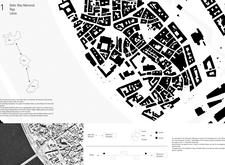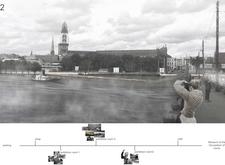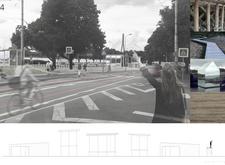5 key facts about this project
At its core, the Baltic Way Memorial represents unity, resilience, and the enduring spirit of the Latvian people. It symbolizes a pivotal chapter in the fight for freedom and highlights the importance of peaceful protest as a means of achieving political change. The project is situated strategically within the urban landscape of Riga, creating a connection between historical narratives and contemporary public life.
The architectural design encompasses a pathway that invites visitors to traverse the memorial while engaging with its ideas and history. This pathway is more than a physical route; it represents the journey taken by the Baltic people towards freedom. As visitors walk along the avenue, they are offered an immersive experience that encourages reflection on the sacrifices made for independence. The design thoughtfully weaves the memorial into the city's fabric, linking it to nearby significant landmarks, such as the Museum of the Occupation of Latvia. This spatial configuration enhances not only the visibility of the memorial but also its accessibility, allowing a wider audience to connect with its message.
The materials chosen for the project reflect careful consideration of both aesthetic and functional aspects. While the specific materials used are not extensively documented, common choices for such architectural memorials often include natural stones like granite or limestone, concrete for structural integrity, and possibly wood for warmth and community spaces. These materials collectively underscore the values of permanence, resilience, and a sense of place, grounding the memorial in its environmental context.
Unique design approaches within the Baltic Way Memorial include the incorporation of multifunctional spaces that accommodate various visitor needs. The presence of exhibition rooms dedicated to the history of the Baltic Way and the surrounding events fosters education and engagement. This educational component is paramount, as it ensures that the stories of resilience and unity are passed down to future generations. Additionally, the inclusion of a café and seating areas promotes a sense of community by encouraging visitors to linger, discuss, and reflect on the themes presented at the memorial.
The architectural design also emphasizes the importance of the natural landscape. By integrating green spaces and open areas, the memorial promotes a tranquil atmosphere conducive to contemplation. This thoughtful approach ensures that visitors have both active and passive ways to engage with the memorial, enhancing their overall experience.
In summary, the Baltic Way Memorial stands as a crucial architectural and cultural landmark in Riga, Latvia. It thoughtfully explores themes of memory, unity, and resilience, representing an important moment in the collective consciousness of the Baltic States. The functional aspects of the design invite public interaction and encourage learning, while the careful selection of materials reinforces the memorial's significance. The integration with the urban environment allows this project to serve as a meaningful space for remembrance and dialogue.
To gain deeper insights into the Baltic Way Memorial, visitors are encouraged to explore architectural plans, sections, and designs that showcase the thoughtful architectural ideas employed in this project. The presentation of this memorial provides a rich context for understanding how architecture can embody historical narratives and foster community engagement.


























